
Expert's Rating
Pros
- Robust build quality
- Superb 4K 120Hz Mini-LED display
- Excellent mechanical keyboard
- Extraordinary CPU and GPU performance
- Lots of connectivity
- Large and heavy
- Attractive but mediocre touchpad
MSI’s mighty Titan 18 HX is a performance powerhouse with gobs of RAM and storage.
Modern Windows laptops can prove extremely powerful, but few take performance as far as MSI’s Titan 18 HX. This is an 18-inch flagship laptop that goes all-in on the latest, quickest hardware and makes zero concessions for weight and portability. It’s a brick—but wow, this brick really flies.
Looking for more options? Check out PCWorld’s roundup of the best gaming laptops available right now.
The MSI Titan 18 HX’s specifications make its performance intent clear. It equips an Intel Core i7-14900HX processor with 24 cores and 32 threads alongside Nvidia RTX 4090 mobile graphics. That’s backed up by an incredible 128GB of DDR5 memory and a 4TB solid state drive. Many laptops have a few of these components, but it’s rare to see them together in one machine.
- CPU: Intel Core i9-14900HX
- Memory: 128GB DDR5 5600MHz
- Graphics/GPU: Nvidia RTX 4090 mobile
- Display: 3840×2400 16:10 Mini-LED 120Hz
- Storage: 4TB PCIe Gen4 NVMe solid state drive
- Webcam: 1080p HDR with IR camera
- Connectivity: 2x Thunderbolt 4 / USB-C 4.0 with USB Power Delivery 3.1 and Displayport Alternate Mode, 3x USB-A 3.2 Gen2, 1x HDMI 2.1, 1x 3.5mm combo audio, 1x SDcard reader, 2.5G Ethernet
- Networking: Wi-Fi 7, Bluetooth 5.4
- Biometrics: Windows Hello facial recognition
- Battery capacity: 99.9 watt-hours
- Dimensions: 15.09 x 12.09 x 1.26 inches
- Weight: 7.93 pounds
- MSRP: $5,399.99
MSI currently offers just two configurations of MSI Titan 18 HX. Most retailers have the model I reviewed, which carries an MSRP of nearly $5,400. Though expensive, it’s a better value than last year’s model, as both the RAM and solid state storage space has doubled. There’s also a variant exclusive to Microcenter which has half as much RAM and retails for about $5,000.
MSI Titan 18 HX: Design and build quality
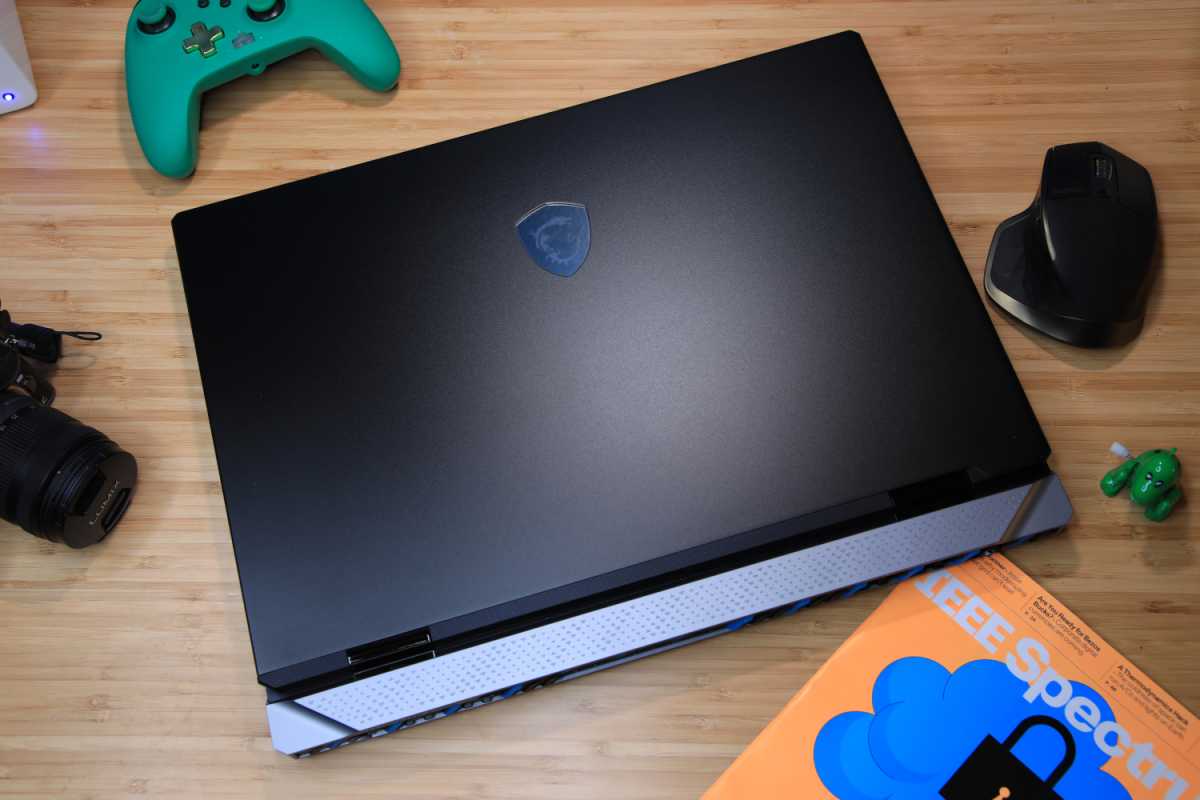
IDG / Matthew Smith
I enjoyed the MSI Titan 18 HX’s predecessor, the Titan GT77 HX 13V, when I reviewed it last year. But I did have one problem: it didn’t feel like a flagship.
Fortunately, the MSI Titan 18 HX solves that.
I’m still not sure the laptop looks like a flagship, as the matte black exterior remains simple, but it benefits from solid materials and construction. Most touch points are metal. The display allows some flex, but not overmuch, and the lower chassis feels like a slate of granite. I was able to find flex in the keyboard tray only after pressing so hard that my fingers hurt.
I suspect a laptop like the Titan 18 HX will take less lumps in its life than most, as it’s too large and heavy for most people to bother with moving frequently. Still, it feels capable of handling a life of travel if the massive 18-inch display—a weak spot on any large laptop—is protected.
Speaking of weight, the Titan 18 HX tips the scales at nearly eight pounds and measures over 15 inches wide, as well as 12 inches deep. It’s not exactly a briefcase PC but it’s certainly among the heavier laptops sold today and won’t fit in a typical backpack’s laptop compartment. The Asus ROG Strix Scar 18 is roughly similar in size (though a bit more narrow), but it weighs over a pound less.
MSI Titan 18 HX: Keyboard, trackpad

IDG / Matthew Smith
The MSI Titan 18 HX’s keyboard is worth talking about. It has Steelseries-branded keyboard with Cherry mechanical key switches and a customizable per-key RGB-LED backlight.
Key feel is excellent, though it might take adjustment. The laptop’s height, alongside its significant key travel in each key, makes typing feel far more similar to a desktop keyboard than most laptops. Each keystroke is received by a crisp, snappy bottoming action and moderate audible feedback.
The key layout makes some tradeoffs. MSI fits a numpad with full-sized keys, which is a great addition for people who need it, but it forces the layout to trim back the Tab, Caps Lock, Shift, and Control keys, as well as a few others. Despite this, I found it plenty spacious.
Keyboard backlight control is offered through Steelseries’ own GG software, not software from MSI. This is probably for the best, as the quality of the Steelseries app is higher than those provided by MSI. The lighting of each key can be customized individually, or owners can choose from one of nearly two dozen presets. There’s a key function and macro editor, too, which is handy if you want to go full nerd and add custom shortcuts.
A modest touchpad sits below the keyboard. It measures just five inches wide and three inches deep, which is small given the laptop’s size. The touchpad is completely flush with the surface of the palm rest, which makes for an attractive look but also makes the touchpad harder to find by feel. MSI tries to combat this by using haptics to simulate a physical click, but it feels as artificial as it is.
That annoyance aside, the touchpad offers two perks. It’s centered in the width of the laptop, not below the keyboard’s spacebar, which is my preference, and it has an RGB backlight. The lighting adds extra flair and, like the keyboard, can be customized with a variety of colors and patterns.
MSI Titan 18 HX: Display, audio

IDG / Matthew Smith
The MSI Titan HX 18 is one of several recent laptops to deliver a massive 18-inch, 16:10 display with a Mini-LED backlight. It also has a resolution of 3840×2400 and a 120Hz refresh rate.
Sharpness is a perk. The 18-inch 4K display packs 251 pixels per inch, which is far higher than the 163 pixels per inch in each inch of a 27-inch 4K monitor. It’s arguably a bit overkill for games but wow, is it sharp. That sharpness is also helpful for content creators, since it lets video editors preview 4K video at the proper resolution and lets photographers and artists see more of a large image file without scaling.
The dynamic Mini-LED backlight delivers excellent contrast and extreme brightness up to and slightly beyond 1,000 nits. That’s way more than the 400 to 500 nits most OLED panels can achieve, and it’s good news for HDR movies and games, both of which offer bright, punchy visuals alongside a deep, immersive image. These results are achieved with 1,008 dimming zones that adjust their brightness independently.
That comes alongside Mini-LED’s usual downside: blooming. Light from small, bright objects can seem to bleed outside them, and the same is true along high-contrast edges. It’s rarely noticeable in movies and games but can be distracting on the Windows desktop (especially if you like to use Dark Mode).
Motion clarity is good, though it depends on your expectations. The 4K Mini-LED panel’s refresh rate of 120Hz is solid for the resolution but way behind competitors that offer 144Hz, 240Hz, or more alongside a lower display resolution. Fast-moving objects in 3D games are usually identifiable but fine details, like small text, are difficult to discern.
In short, the display leans towards content creators and PC gamers who prefer maximum sharpness and detail over framerate. If that sounds like you, you’re going to love it. If not, you might prefer the display on the Asus ROG Strix Scar 18, which sticks to 2560×1600 resolution but offers a 240Hz refresh rate.
The excellent display is joined with strong speakers that line the sides of the keyboard. Their position provides clear audio that’s not muffled by the surface the laptop is placed on. A 2-watt subwoofer inside the laptop joins them to add some bass. It all adds up to a crisp, enjoyable presentation with oomph bass-heavy tracks, though the laptop’s maximum volume is a tad lower than I expected. I still recommend headphones if you want to immerse yourself in a movie or game, but the speakers are great for casual listening.
MSI Titan 18 HX: Webcam, microphone, biometrics
MSI hides a 1080p webcam in the Titan’s top bezel. It’s a thoroughly acceptable webcam with decent sharpness, good color, and clever automatic exposure. Video looks clean and crisp on Zoom but falls short of what I’d want for recording to YouTube or even Instagram.
The webcam is paired with an IR sensor that enables support for Windows Hello facial recognition login. It’s a common feature for an expensive Windows laptop, but still appreciated, and it works as well here as anywhere. Windows detected my face in the blink of an eye and worked as well in a dark room as one that’s brightly lit.
A physical privacy shutter is provided to obstruct the 1080p webcam. It doesn’t include an electronic cut-off, though, so it’s still possible to record video and audio while the camera is covered.
The built-in microphone array works well. It captured my voice with ease even when I spoke in a near-whisper or when I faced away from the webcam. Despite that, the array rejected repetitive ambient noise from a space heater in the same room. Audio from the microphone array tends to sound hollow on critical listening, as true of most laptop microphone arrays, but it’s solid for video conferencing and voice chat
MSI Titan 18 HX: Connectivity
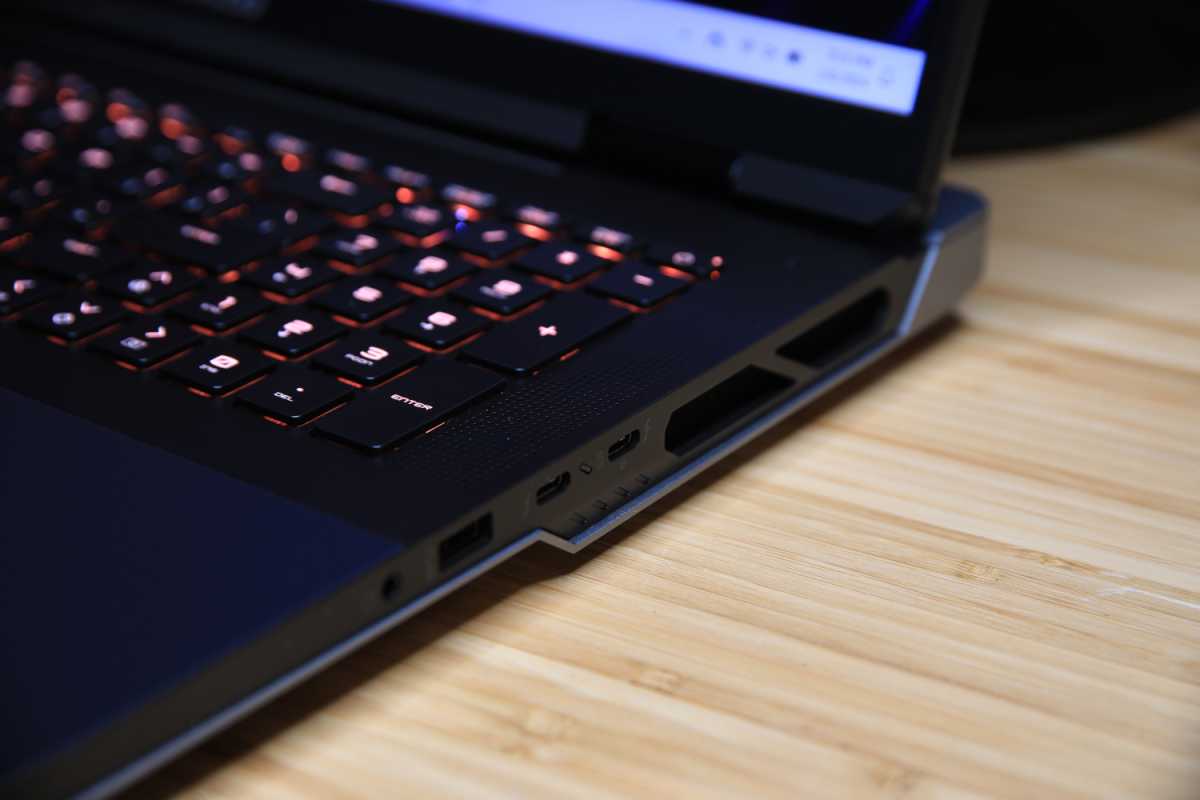
IDG / Matthew Smith
MSI takes an all-the-things approach to connectivity with the Titan 18HX. It has two Thunderbolt 4 ports, both of which support USB 4 and DisplayPort alternate mode, and three USB-A 3.2 Gen 2 ports for older devices. HDMI 2.1 provides additional video-out. The laptop also has a full-sized SD card reader, a 3.5mm combo audio jack, and a 2.5G Ethernet port.
That’s a heaping helping of connectivity, and it’s well-distributed across the laptop’s flanks. Ports can be found on both sides and the rear of the laptop. My only complaint is the location of the Thunderbolt 4 ports, both of which cluster on the right flank and are placed closer to the middle of the laptop than its rear. You’ll have to deal with an inconvenient cord when a USB-C or Thunderbolt 4 dock is connected.
Network connectivity is strong, as well, with support for the latest Wi-Fi 7 standard and Bluetooth 5.4, and 2.5G Ethernet. That’s as good as it gets for a laptop sold in 2024. While Wi-Fi performance can vary between networks and locations, I found the Titan HX 18 performed remarkably well, achieving download speeds at the maximum of my home Gigabit internet service when connected over Wi-Fi 6E. This was true even when the laptop was a couple rooms away from my router.
MSI Titan 18 HX: Performance
The MSI Titan 18 HX spares no expense when it comes to its internals. The laptop has Intel’s Core i9-14900HX, a 24-core, 32-thread processor with a maximum Turbo Boost clock speed of 5.8GHz. That’s paired with Nvidia’s RTX 4090 mobile graphics, 128GB of DDR5 memory, and a 4TB PCIe NVMe solid state drive. It’s an impressive list of specifications, and it delivers great performance.
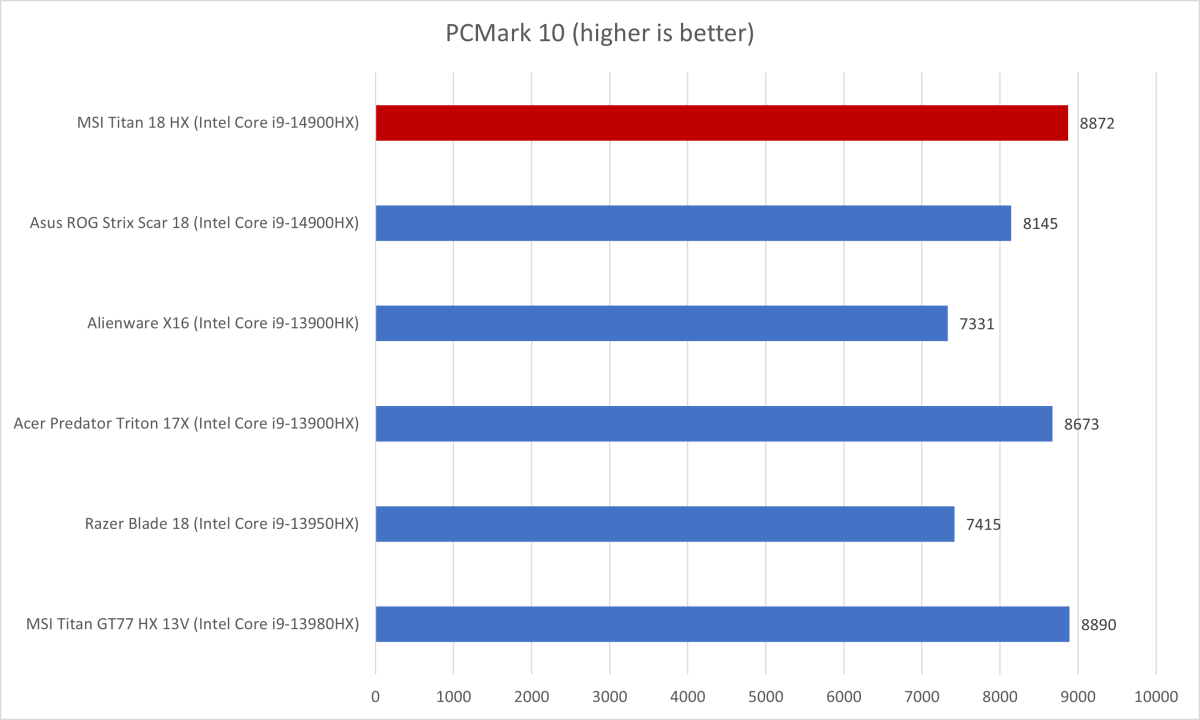
IDG / Matthew Smith
We start off in PCMark 10, a holistic system benchmark that tests multiple aspects of a laptop’s hardware. Here the MSI Titan 18 HX achieves an excellent score of 8,872. That’s a sliver behind last year’s model, which achieved 8,890, but it beats most similar laptops we’ve tested, and it’s the second-best score we’ve received in PCMark 10 when testing a laptop in its default power profile.

IDG / Matthew Smith
Next up is Cinebench R20, a heavily multithreaded but short-duration benchmark. The Intel Core i9-14900HX’s high thread is at home in the beefy MSI Titan 18HX, which offers both the power and cooling to let it perform at its best. The result is a fantastic score of 12,022. Intel’s many-core design clearly pays dividends here.

IDG / Matthew Smith
Handbrake is another heavily multithreaded benchmark, though with a much longer duration that tests a laptop’s ability to vent heat over time and keep the processor running at high clock speeds. The bulky Titan again does extremely well here, though it doesn’t run away from the pack. The Asus ROG Strix Scar 18 and Acer Predator Triton 17X reached near-identical performance.
Now it’s time to move on to graphics performance. Nvidia’s RTX 4090 is the only option in the MSI Titan 18 HX, and it operates at its peak power draw of 150 watts (or 175 watts under dynamic boost). The results continue to impress.
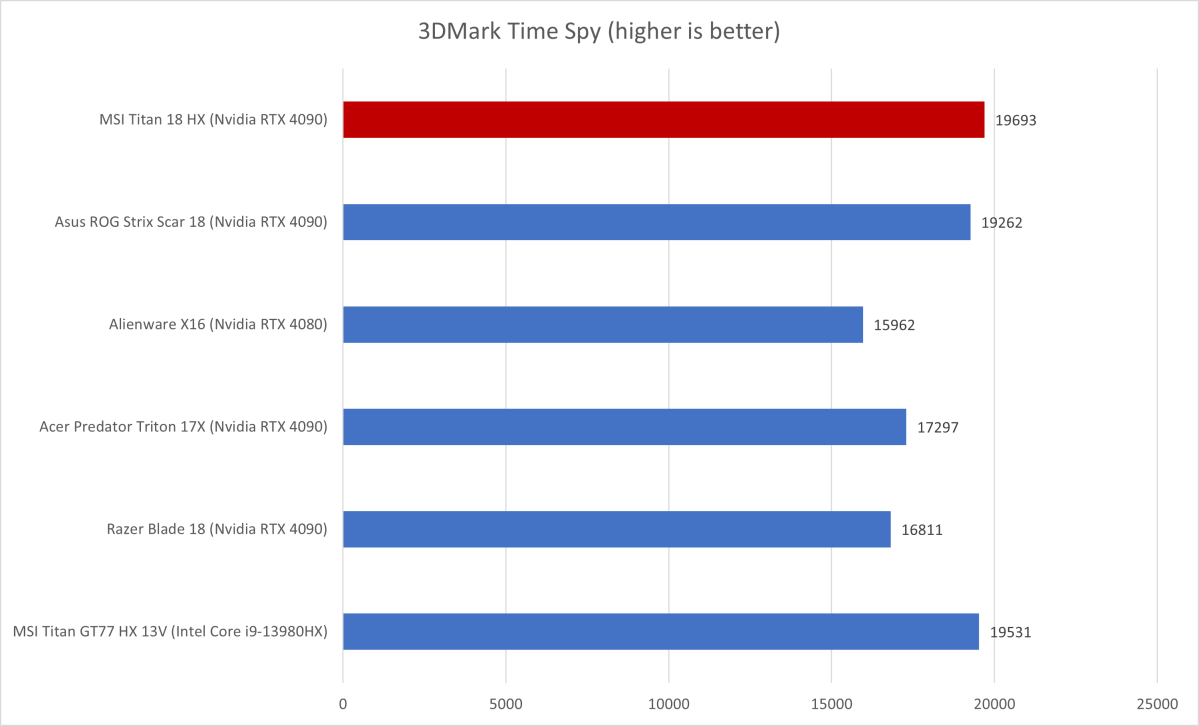
IDG / Matthew Smith
The Titan gets off to a great start in 3DMark Time Spy, where it achieves an outstanding score of 19,693. That’s a new record for a laptop in its default performance profile and it easily crushes most competitors, including some that are themselves excellent performers, like the Acer Predator Triton 17X.

IDG / Matthew Smith
Next up is Shadow of the Tomb Raider, a console title from the PlayStation 4 and Xbox One generation. It can still tax integrated graphics and entry-level discrete graphics, but laptops of this caliber tear through it at nearly 200 frames per second. The MSI Titan HX 18 doesn’t win here, but it also doesn’t lose: it exactly ties the Asus ROG Strix Scar 18, and its loss to the Acer Predator Triton 17X is just three frames per second.

IDG / Matthew Smith
Metro Exodus, a more demanding game from the same console generation that’s received updates appropriate to the latest gaming PCs, performs extremely well, too. It hit an average of 87 frames per second at 1080p resolution and the Extreme detail setting, which lives up to its name. That ties the old MSI Titan GT77 HX 13V and beats several alternative laptops.
All of the benchmark results above were recorded with the laptop in the Balanced power profile but, like most such laptops, MSI provides a high-performance profile. It delivered a small but meaningful boost that in some cases allowed the Titan 18 HX to set new performance records for a laptop. This was true in 3DMark Time Spy, where the laptop scored 20,915.
If there’s a downside, it’s shared with the Asus ROG Strix Scar 18: the new laptop isn’t much quicker than last year’s model. The Titan 18 HX defeats the Titan GT77 HX 13V in most benchmarks, and it also defeats the Asus ROG Strix Scar 18 overall, but the margin is often slim.
But the MSI Titan 18 HX chalks up plenty of wins and even in those situations where it did fall behind competitors, it still nipped at their heels. Don’t forget the RAM, either. Most people don’t need 128GB of memory but if you do, you do, and the Titan is reasonably priced for a laptop with RAM in the triple digits.
MSI Titan 18 HX: Battery life
MSI provides a 99.9 watt-hour battery to power the laptop when it’s away from a socket. That’s the largest you’ll find available in any laptops due to FAA regulations on the size of batteries allowed on flights. Even so, it’s hard-pressed to keep the thirsty Titan satisfied.
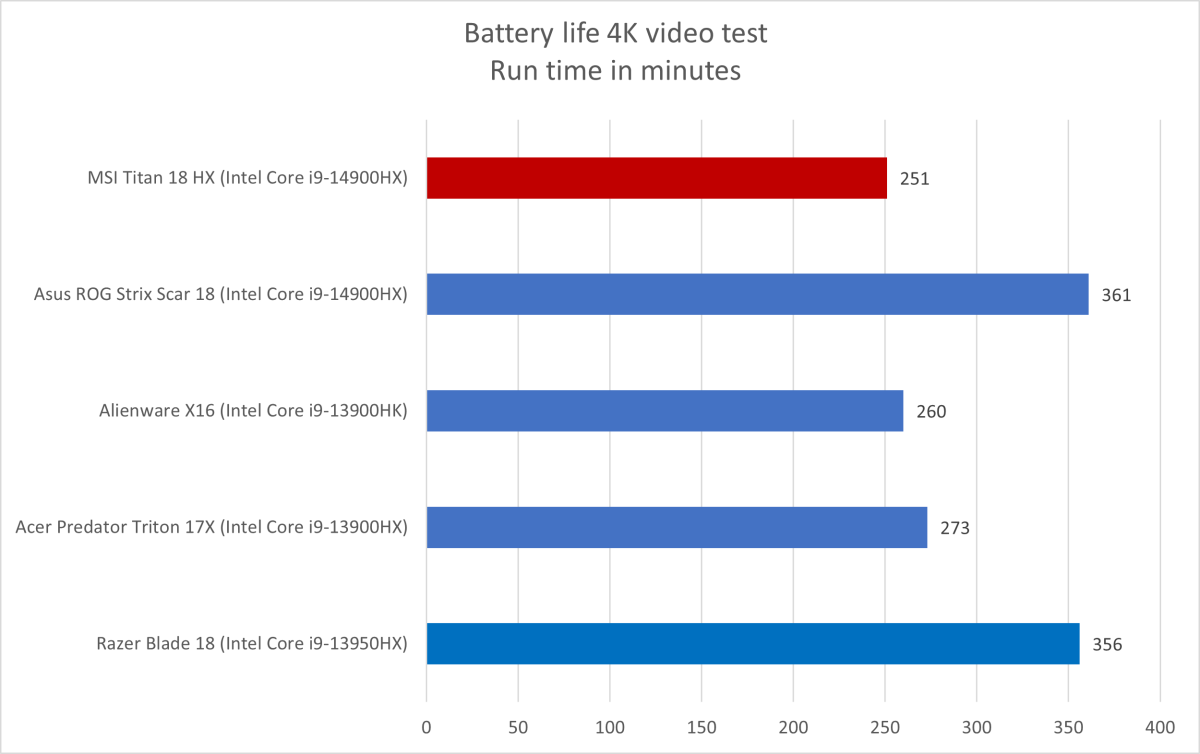
IDG / Matthew Smith
The Titan endured a bit more than four hours of use in the Balanced power profile with Hybrid graphics (which relies on Intel integrated graphics when the mighty RTX 4090 isn’t required) turned on. That’s not a terrible result for a high-performance laptop, but it’s not great, either. Turning Hybrid graphics off cut battery life further to just a smidge over two hours.
Charging isn’t easy, either, as the laptop has hefty power requirements and ships with hefty 400-watt power brick. One of the laptop’s two Thunderbolt 4 ports supports USB Power Delivery, but it doesn’t provide enough power to fully handle the laptop under load, so the power brick is required for the best performance and quickest charging times.
None of this comes as a shock. The Titan is a big, power-hungry laptop, and pays for it with portability. I don’t recommend it as a travel companion unless you absolutely need the performance it can deliver.
MSI Titan 18 HX: Conclusion
The MSI Titan 18 HX is a flagship laptop that delivers great build quality, an excellent keyboard, a fantastic 4K Mini-LED Display, and strong overall performance. It defeats other flagship laptops, like the Asus ROG Strix Scar, and slightly outperforms 2023’s Titan GT77 HX 13V in some, though not all, benchmarks. The new Titan 18 HX also doubles the RAM and solid state storage found in last year’s model at a similar price.
There are a few downsides. It’s a large laptop with short battery life and, despite better performance, it’s arguably not as good value-for-money as the less expensive Asus ROG Strix Scar 18, which is $1,000 less but just a tad slower in our benchmarks.
Still, I think most shoppers looking at a laptop in this price and weight class expect it to push the limits in performance, features, and quality at once. That’s exactly what the Titan 18 HX does.
Laptops
